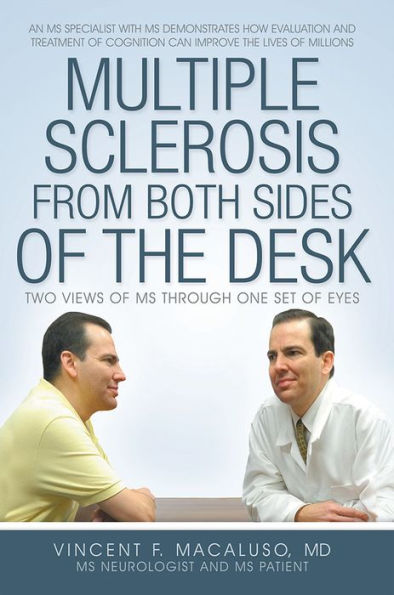Multiple Sclerosis from Both Sides of the Desk: Two Views of Ms Through One Set of Eyes
“Dr. Macaluso has written the Iliad and the Odyssey of multiple sclerosis while playing the part of Odysseus. Amazing!” Carlo Tornatore, MD, Vice Chairman, Department of Neurology Georgetown University Hospital, Washington, DC Vincent F. Macaluso was in medical school when he got the news: he had multiple sclerosis. He soon learned that almost a half million people in the United States have multiple sclerosis—and millions more worldwide. Many have obvious symptoms, such as trouble with walking, balance, and coordination, but the most insidious aspect of the disease is how it affects the mind. Macaluso shares insights from his vantage point as a doctor and an MS patient, helping his peers understand symptoms they may not grasp and offering wisdom for those who live with the disease. Learn how to • anticipate and overcome problems concentrating; • manage swirling emotions; • understand MS from a neurological standpoint; • preserve and continue to enjoy an active sex life; and • prevent the disease from ruining family life. Laced with humor and filled with diagrams and the author’s own recollections about how he’s kept MS from controlling his life, this account is essential reading for doctors, patients, and anyone who has an MSer in his or her life.
1122056705
Multiple Sclerosis from Both Sides of the Desk: Two Views of Ms Through One Set of Eyes
“Dr. Macaluso has written the Iliad and the Odyssey of multiple sclerosis while playing the part of Odysseus. Amazing!” Carlo Tornatore, MD, Vice Chairman, Department of Neurology Georgetown University Hospital, Washington, DC Vincent F. Macaluso was in medical school when he got the news: he had multiple sclerosis. He soon learned that almost a half million people in the United States have multiple sclerosis—and millions more worldwide. Many have obvious symptoms, such as trouble with walking, balance, and coordination, but the most insidious aspect of the disease is how it affects the mind. Macaluso shares insights from his vantage point as a doctor and an MS patient, helping his peers understand symptoms they may not grasp and offering wisdom for those who live with the disease. Learn how to • anticipate and overcome problems concentrating; • manage swirling emotions; • understand MS from a neurological standpoint; • preserve and continue to enjoy an active sex life; and • prevent the disease from ruining family life. Laced with humor and filled with diagrams and the author’s own recollections about how he’s kept MS from controlling his life, this account is essential reading for doctors, patients, and anyone who has an MSer in his or her life.
3.99
In Stock
5
1

Multiple Sclerosis from Both Sides of the Desk: Two Views of Ms Through One Set of Eyes
394
Multiple Sclerosis from Both Sides of the Desk: Two Views of Ms Through One Set of Eyes
394
3.99
In Stock

Product Details
| ISBN-13: | 9781491757475 |
|---|---|
| Publisher: | iUniverse, Incorporated |
| Publication date: | 06/02/2015 |
| Sold by: | Barnes & Noble |
| Format: | eBook |
| Pages: | 394 |
| File size: | 10 MB |
About the Author
From the B&N Reads Blog
